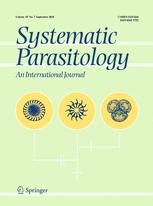View Item
- xmlui.general.dspace_homeCentros Regionales y EEAsCentro Regional Santa FeEEA RafaelaArtículos científicosxmlui.ArtifactBrowser.ItemViewer.trail
- DSpace Home
- Centros Regionales y EEAs
- Centro Regional Santa Fe
- EEA Rafaela
- Artículos científicos
- View Item
Amblyomma hadanii n. sp. (Acari: Ixodidae), a tick from northwestern Argentina previously confused with Amblyomma coelebs Neumann, 1899
Abstract
All stages of Amblyomma hadanii n. sp. (Acari: Ixodidae) are described from northwestern Argentina. The diagnostic characters for males are a combination of the pattern of scutal ornamentation, basis capituli dorsally rectangular with cornua, coxa I with two subequal spurs (the internal wider, the external longer), coxae II-III with a single spur, coxa IV with a single spur not reaching level of anus, ventral plates irregular in shape (larger and
[ver mas...]
All stages of Amblyomma hadanii n. sp. (Acari: Ixodidae) are described from northwestern Argentina. The diagnostic characters for males are a combination of the pattern of scutal ornamentation, basis capituli dorsally rectangular with cornua, coxa I with two subequal spurs (the internal wider, the external longer), coxae II-III with a single spur, coxa IV with a single spur not reaching level of anus, ventral plates irregular in shape (larger and sometimes with a small incision on festoons 4, 5 and 6) and hypostome spatulate with dental formula 3/3 in 7–8 rows. The diagnostic characters for the females are a combination of scutal ornamentation, postero-lateral margins of scutum slightly convex, coxa I with two subequal spurs (the internal wider, the external longer), basis capituli dorsally rectangular, porose areas rounded, genital aperture U-shaped, and hypostome spatulate with dental formula 3/3 in 7–8 rows. Diagnosis of nymphs can be performed by a combination of basis capituli rectangular, scutum with large punctations in the lateral fields and small punctations in the central field, and cervical groove short and ending as a small shallow depression at the eye level. Larvae are diagnosed by the shape of basis capituli, scutum with with posterior margin slightly convex, and legs with coxa I with 2 triangular spur (the external longer than the internal), and with coxae II and III each with 1 triangular spur. The hosts recorded for this new tick species are Tapirus terrestris (Linnaeus), horse, cattle, dog and humans. Analyses of a 410 bp fragment of the mitochondrial 16S rRNA gene and the complete sequence of the nuclear 18S rRNA gene supported the description of A. hadanii as a new species.
[Cerrar]

Author
Nava, Santiago;
Mastropaolo, Mariano;
Mangold, Atilio Jose;
Martins, Thiago F.;
Venzal, José Manuel;
Guglielmone, Alberto;
Fuente
Systematic Parasitology 88 (3) : 261–272. (July 2014)
Date
2014-07
ISSN
0165-5752
1573-5192
1573-5192
Formato
pdf
Tipo de documento
artículo
Palabras Claves
Derechos de acceso
Restringido
 Excepto donde se diga explicitamente, este item se publica bajo la siguiente descripción: Creative Commons Attribution-NonCommercial-ShareAlike 2.5 Unported (CC BY-NC-SA 2.5)
Excepto donde se diga explicitamente, este item se publica bajo la siguiente descripción: Creative Commons Attribution-NonCommercial-ShareAlike 2.5 Unported (CC BY-NC-SA 2.5)

